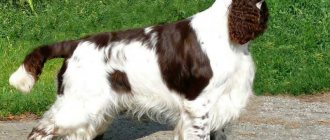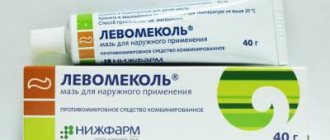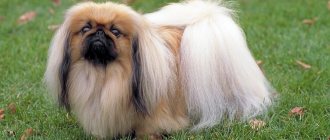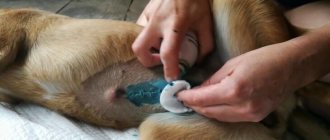What is the best way to feed a puppy?
Before preparing your dog’s daily diet, you need to decide what kind of food you are going to give your pet. There are only 2 options: ready-made dry food or natural food, represented by meat, grains, vegetables and fruits. Each of these cases has its own characteristics of feeding products.
Dry food
Among the dry food mixtures for dogs on the market, there are both economy-class products and more expensive premium food and holistic food. Considering the high need of a growing body for vitamins and minerals, it is better for the owner to pay attention to the latest options, which are distinguished by a higher quality composition. A veterinarian will help you decide on the brand of food, taking into account the health of the animal and its breed characteristics. If you rely only on consumer reviews, then for puppies of small breeds (for example, Yorkshire terrier or Spitz), the following products will be a good solution for regular feeding:
- Guabi Natural for puppies;
- Acana Heritage;
- Applaws with chicken.
For babies of larger breeds (Alabai or Shepherd) it is better to choose puppy food from one of the following companies:
- Acana Heritage;
- "Orijen"
- “Savarra with lamb and rice”;
- "Applaws."
If the owner does not have the opportunity to purchase dry food for puppies of a specific breed, you can always buy universal food suitable for babies of any breed. Popular products in this direction are:
- Orijen grain-free food;
- hypoallergenic composition with lamb and rice for puppies prone to allergic reactions (for example, pugs, bulldogs, Shar Peis, Pekingese);
- with salmon and turkey Carnilove;
- with potatoes and salmon Optima Nova Sensitive;
- with trout and salmon Barking Heads Puppy Days.
It is not necessary to soften dry kibble before giving it to your puppy. Two-month-old kittens can already chew them on their own, but if the baby does not like the smell or consistency of such food, at first you can soak it in warm boiled water, leaving it covered for 30–40 minutes.
Did you know? If a puppy does not interact with people in the first three months after birth, it will remain wild for the rest of its life. Scientists consider Australian dingoes to be a separate species of such feral domestic dogs.
homemade food
Homemade food may well become an alternative to complete ready-made food, but only if the dog owner can accurately calculate the volume of certain products required for puppies. A natural menu for two-month-old pets usually consists of:
- low-fat varieties of meat (chicken, beef, veal, turkey, rabbit), which, before giving it to your pet raw, must be frozen in the refrigerator for at least three days and then cut into not very small pieces;
- meat by-products (beef tripe, liver, heart and udder), the volume of which should exceed the amount of pure meat by one and a half times and be given to the dog no more than 1-2 times every 7 days;
- cereals (oatmeal, buckwheat and rice);
- dairy products (kefir, cottage cheese, yogurt), which are introduced into the puppies’ diet every other day;
- vegetables (most often small puppies and adult animals are given pumpkin crops, carrots, broccoli and cauliflower, but you should also focus on the kitten’s personal preferences.
Before giving the puppy vegetables, they are boiled or steamed, adding a small amount of vegetable oil, but in the intervals between main feedings, you can give your pet raw foods to improve the functioning of the stomach and strengthen the jaw.
Boneless sea fish scalded with boiling water, fruits, berries and eggs, boiled in the usual way or raw, will help diversify the diet of a two-month kitten. You can replace meat with fish once or twice a week, but due to its lower calorie content, it will require 2 times more than beef or rabbit meat, so owners are not always ready to change their usual regimen.
Important! Meat should not be combined with dairy products, since different intestinal enzymes are needed to digest these products.
It is advisable to give meat food to your pet in combination with vegetables, and cook porridge in water or broth, with the introduction of plant ingredients.
Features of feeding
The topic of feeding a puppy is inexhaustible. Scientists are constantly making various discoveries in this area, trying to protect our furry pets. Feeding a puppy should be taken seriously; the foundation for the dog’s health is laid at an early age.
It is important to give breastfed babies various vitamins and microelements as a nutritional supplement. Products may not meet all regulations. For puppies receiving dry food, such a supplement will be unnecessary and even dangerous.
In autumn and winter, puppies should be given fish oil with vitamins A and D for proper bone formation and the prevention of rickets.
And finally, the question that concerns many people is the need to add salt to puppies’ food. Here you should rely more on your intuition, and not on the advice of “experienced” people. The best option is a pinch of salt once a day in some dish, for example, in porridge.
It’s definitely not a good idea to salt your dog’s food for yourself, just as you shouldn’t completely deprive your pet of table salt. All living beings need it in small quantities for water-salt balance.
How many times a day should you feed a two month old puppy?
Like a one-month or one-and-a-half-month-old baby, a two-month-old kitten is fed at least 5-6 times a day, with an interval of three hours. That is, the appropriate daily food intake should be divided into 5-6 equal parts, even if they seem very small to the owner. If the puppy has not finished the offered portion, the bowl is still removed in order to add the remaining food to the next portion.
For convenience, the daily amount of dry food can be weighed every morning, poured into a tightly closed container with marks on the wall. Using them, it will be much easier to navigate the required amount of food at each daily feeding and you will not have to worry about exceeding the maximum possible daily feed allowance.
What to feed 2-month-old puppies of small, medium and large breeds: natural food
If the natural type of feeding is taken as the basis, then the basic principles of creating a diet for puppies of two months of age will be as follows:
- All products must be fresh and food must be prepared for one day.
- The food is salted, but by the standards of human nutrition it remains unsalted.
- At least a third of the diet consists of lean meat.
- Cereals are taken with a low glycemic index.
- Vegetables are required in the diet, as are fermented milk products.
- A required ingredient is fat and oil.
- Don't forget about vitamin supplements.
- Water is an integral component of the diet.
How to Calculate Serving Size
The easiest way is to calculate the optimal daily amount of food for a two-month-old puppy if the owner decides to use dry food. Most manufacturers of such products think about this in advance, placing on food boxes a detailed table with the dosage of granules for puppies, taking into account their weight. On average, for small breeds (up to 2-3 kg of an adult) 50–65 g of food per day is required, and for large babies with an adult weight of 26–29 kg - at least 245 g. At the same time, for the health of joints and everything musculoskeletal system of large animals, it is better to slightly underfeed the puppy, thereby preventing its obesity and excessive weight gain. There should be at least 260–270 kcal per 1 kg of pet weight, that is, about 6-7% of the animal’s total weight.
Normally, the puppy eats the given portion in just 10–15 minutes, leaving the bowl empty. If the pet swallows the offered food in just 2-5 minutes and licks the dishes for a long time, the puppy definitely does not have enough food and it is worth increasing the portion
An interesting way to calculate the optimal amount of natural food for a two-month-old puppy would be to give a known large amount of food. As soon as the dog’s last ribs are released during eating, the bowl is taken away to slightly underfeed the pet. Typically, this method is used when keeping lean hunting breeds: shorthaired pointers, drathhars, Russian hunting dogs and spaniels.
What else can you give?
In addition to natural products or ready-made dry food, separate vitamin and mineral supplements and treats are often introduced into the diet of two-month-old puppies. They not only make the animal’s menu more varied, but also have a positive effect on its health, although for maximum benefit it is worth knowing about some of the features of issuing each supplement.
We recommend reading how to feed your dog dry food, feeding features, benefits and harm.
Vitamins and other supplements
When using high-quality premium or holistic food to feed puppies, you don’t have to buy separate vitamin and mineral formulations, since the animal already receives all the nutrients it needs. Excessive amounts of vitamins and minerals in the diet will lead to hypervitaminosis, so it is better to include nutritional supplements only when puppies are fed a natural diet, which is much more difficult to balance.
There are two main types of vitamin-mineral complexes:
- ready-made mixed products, the best among which are considered to be the compositions “Excel Multi Vit 8 in 1”, “Beaphar for puppy”, “Canvit Junior”, “Biori” products;
- natural - feed sulfur, brewer's yeast, bone meal, calcined cottage cheese, fish oil.
Two-month-old puppies of large breeds with significant body weight are additionally included in the menu with calcium, magnesium, and phosphorus, which ensure proper formation of the skeleton and prevent rickets. Fish oil, vitamins A and D, given to dogs during the cold season, will be especially useful for prevention purposes.
Treats for dogs
Treats are the easiest way to encourage your puppy to behave correctly, especially if the baby has just begun to get acquainted with the rules in the house. If possible, it is better to give preference to completely natural treats in the form of cured and dried meat and deer antlers. An alternative solution would be ready-made pellets and stringy bones from a pet store. Products from and “Orijen” are deservedly considered a good example of such products, but you should not abuse them. Like food, treats contain a significant supply of calories, so treats should take up no more than 10% of the total daily food intake. A budget option for homemade delicacies would be bread crumbs and oven-dried cheese.
Important! When preparing any type of treat for a two-month-old puppy, you cannot use salt, pepper or any other spices.
Industrial feeding of a puppy at 2 months
If you decide to feed your puppy commercial food, it is important to understand that its growth and development directly depend on the quality of the product. For convenience, product quality is graded into classes: economy, premium, superpremium and holistic.
- If you intend to raise a healthy dog, keeping it on economy class food is unacceptable.
- Premium food may contain insufficient proteins and/or an incomplete vitamin complex.
- Super premium class food usually contains a sufficient amount of proteins and a full range of vitamins.
- The quality of holistic feeds is as close as possible to natural products.
Canned food or dry food?
At two months of age, the puppy should receive commercial food in the form of canned food, paste or kibble with gravy (suitable for large breeds). Dry food is introduced into the pet’s diet only after the complete replacement of milk teeth. From 4 months of age, so that the baby gets used to the taste of dry food, it is gradually introduced into the diet in a soaked form.
Before feeding, dry food granules must be filled with hot water and left for 10–15 minutes . When the granules gain moisture and increase in volume, they must be crushed and mixed with canned food. To make the puppy more willing to eat mixed food, you need to add more aromatic gravy to it.
Water in a puppy's diet
Puppies at the age of 2 months drink water extremely reluctantly. Regardless of the type of food, the baby gets enough water by absorbing food. By 4 months of age, if you decide to switch your pet to commercial food, he needs to be taught to drink water!
Be sure to make sure that your pet goes to the drinking bowl immediately after eating. If for some reason your puppy ignores the water bowl, try replacing the water with milk or broth. At 2 months of age, it only takes a few hours for a puppy to develop dehydration.
What not to give to 2-month-old puppies
Not all food from the owner’s table benefits the body of an adult dog, let alone a puppy. The smaller the breed, the more dangerous a small piece of smoked sausage or a tiny piece of chocolate will be for the animal. It is quite difficult to predict the reaction of your pet’s body to prohibited foods, but in order to prevent serious problems with the health of the animal, it is better to avoid the components of the following list:
- salty, smoked, fatty and fried dishes from the human table;
- sausages, canned meat and vegetables in all its forms;
- semi-finished products and food from fast food establishments;
- citrus fruits, grapes and raisins from them;
- garlic and onions;
- confectionery and bakery products, sweets (especially chocolate);
- mushrooms and nuts;
- alcoholic, carbonated and sweet drinks.
In some cases, such products have a cumulative effect and do not immediately show their negative effects on the dog’s body, in others they can lead to intoxication or an immediate allergic reaction after just one use by the puppy.
In addition to this dangerous food, there is also a group of “conditionally dangerous” products, the dangers of which owners constantly argue with each other. First of all, this:
- fatty thermally unprocessed pork, which may well contain eggs and larvae of worms;
- potatoes - when boiled, they contain a lot of starch (you can pamper an adult pet with a few slices of the tuber, but it’s better not to give it to puppies);
- tomatoes - they remove dental plaque well, but if consumed excessively they can cause serious poisoning in a dog;
- honey is an allergenic product, but at the same time it is also a storehouse of useful substances, so it is occasionally included in the diet in small quantities;
- pearl barley and semolina - contain a lot of carbohydrates, the excessive accumulation of which leads to bloating and excess weight, however, for actively growing two-month-old babies, semolina porridge with milk will be useful if there is insufficient weight gain;
- legumes - always cause flatulence and the associated restless behavior of the puppy, but if an adult dog loves peas or beans, then a few grains will not cause harm.
Whatever you start feeding your little puppy, always carefully monitor his body’s reaction to the new product. If vomiting, diarrhea or any allergy symptoms appear, it must be excluded from the diet.
Find out also what kind of meat can be given to dogs and feeding rules.
Puppy oral care
Many owners think that caring for a puppy does not require brushing its teeth, because the baby still has milk teeth that will change anyway. But this approach is fundamentally wrong. Firstly, gum inflammation negatively affects the cardiovascular and immune systems. Secondly, it is necessary to accustom a puppy to cleaning and examining the oral cavity from childhood, so that an adult dog is calm about this procedure.
So, caring for a small puppy includes regular oral examinations. And the more often you do it, the faster the dog will get used to the fact that a person is trying to get into his mouth with his hands. To examine the teeth, place one hand under the puppy's lower jaw and lift the dog's upper lips with the other hand. First, you need to ensure that the puppy allows you to examine his teeth for at least a few seconds. Don't forget to praise your baby!
To accustom your puppy to brushing his teeth, wrap gauze around your finger, soak it in warm boiled water and lightly rub the dog's front teeth. There is no need to immediately go deep into the molars.
Important:
Brushing baby teeth is more of a puppy training exercise than a serious prevention of oral diseases, so there is no need to use toothpastes. Before brushing your puppy's teeth, you should thoroughly wash your hands with germicidal soap.
You can read about oral care for an adult dog here
Nutritional features of puppies of different breeds
Representatives of different breeds of dogs differ from each other in their appearance, character and temperament, which in some cases affects the pet’s increased activity and, as a result, high energy consumption. This feature must be taken into account when preparing the diet for small, medium and large animals.
Small
Decorative dogs are very popular in the city because they do not take up much space and can easily do without a long walk. The most common breeds today are the miniature pinscher, Yorkshire terrier, chihuahua, mini poodle, toy terrier, Pekingese and other dogs whose weight does not exceed 10 kg. At first glance, they eat little and are not at all picky in choosing food, but this is not at all the case.
Two-month-old toy and small breed puppies spend a lot of energy maintaining their body temperature, not to mention the increased energy expenditure due to their high natural activity. To make up for losses, the body needs very high-calorie food, rich in proteins and carbohydrates, given to animals in small portions. Natural products are crushed, and dry food granules are soaked in water so as not to damage the dogs’ weak teeth.
An approximate menu for two-month-old small breed puppies could be like this:
- 7:00 - porridge with milk and a small piece of chicken egg (for example, 1/4);
- 10:00 - grated carrots or apples, with a small addition of vegetable oil;
- 13:00 - cottage cheese stirred in kefir;
- 15:00 - meat or fish with grated vegetables, seasoned with broth;
- 18:00 - vegetables stewed in olive oil;
- 21:00 - meat by-products or meat, previously finely chopped and heat-treated.
Meat in the daily diet of a two-month-old small breed puppy should make up at least 40% of the total daily food intake.
Average
Among the representatives of medium-sized breeds of domestic dogs, the most common are Jack Russell Terriers, Labradors, Cocker Spaniels, Staffordshire Terriers, German Pinschers and medium-sized Spitz dogs. Already at two months of age, the size of animals of medium breeds is very different from the parameters of their dwarf relatives, although they spend not much less energy.
Meat, kefir and yoghurt in the diet of these animals should take up at least 50–60% of the daily volume of food, and the remaining 40% usually comes from vegetables, fruits and cereals.
Did you know? The oldest officially registered dog in the world is a terrier mix named Max. He died in 2013, just short of his 30th birthday.
An approximate daily menu for such dogs might look like this:
- 7:00 - cottage cheese with sour cream;
- 10:00 - meat or fish scalded with boiling water, with prepared grated vegetables;
- 13:00 - milk porridge (semolina is possible) and half a boiled egg;
- 15:00 - porridge with zucchini, carrots or broccoli, covered in broth;
- 18:00 - porridge with milk;
- 21:00 - finely chopped raw meat.
You can change the “dishes” at your discretion, the main thing is that the pet’s diet is varied and as balanced as possible in terms of vitamin and mineral composition.
Large and gigantic
Raising strong and healthy puppies of large or giant breeds is much more difficult than raising small and medium-sized animals. Alabais, Dobermans, Rottweilers, St. Bernards, East European Shepherds, Great Danes and Newfoundlands are already quite large at 2 months, while continuing to grow rapidly. The bones do not always have time to strengthen, so deformation and curvature of the paws may occur. To prevent this from happening, it is very important to take a responsible approach to compiling the animal’s diet, paying special attention to the calcium content of food.
The menu for a large breed puppy should consist of the following products:
- meat, fish, offal and dairy products rich in animal protein (at least 60% of the total food per day);
- grains and cereals that replenish the body’s carbohydrate reserves (20–30% of the total daily requirement);
- vegetables and fruits rich in fiber (10–15% of the total daily food intake);
- chondroprotectors - special additives necessary for the proper formation and strengthening of cartilage, joints and ligaments.
The daily menu for two-month-old large and giant breed puppies looks like this:
- 7:00 - cottage cheese covered with yogurt or milk;
- 10:00 - finely chopped meat, with boiled vegetables and a teaspoon of olive oil;
- 13:00 - buckwheat porridge cooked in meat broth;
- 15:00 - rolled oats or rice with milk;
- 18:00 - chopped vegetables and fruits;
- 21:00 - chopped offal, fish or meat, cooked with the addition of oil.
Some dogs do not like vegetables and fruits in their pure form. You shouldn’t force feed them to your pet, but in order not to deprive the dog’s body of nutrients, you can lightly boil carrots or broccoli and add it to the meat in this form, as if hiding it behind it.
It will be useful for you to read how signs of food allergy appear in dogs, why it appears and what to do.
Aspects of education
Sometimes, with the best of intentions, new owners do too much to relieve the puppy from the stress of separation from its mother. This applies to being with the baby every minute, feeding in places not intended for eating, constantly being carried in arms and other things.
You should understand: the puppy will grow up, but the habits will remain.
The older the dog gets, the less affection his pranks cause, and over time, the dog still begins to instill good manners. Late socialization and learning the rules of behavior in the house are painful for animals and traumatic for the psyche.
Prioritization or who is boss in the house
In order for the puppy to learn from the first days the arrangements in the “pack”, where the leader will be a person, you need to adhere to some rules:
- Both the dog and the owner have the right to privacy. You cannot spend all your free time with the puppy - the puppy must be able to occupy itself. After playing with your pet, you should leave him alone and go about your business. You can defiantly ignore him for a while: the baby will calm down and stop bothering you.
- You need to teach your dog to stay home alone. You need to do this from the first day, going out the door for a few minutes. It is important that the puppy sees this happening and does not sleep during this time. Over time, the “care” intervals are increased, but no more than an hour in the first few days. During the period when the baby is left alone, he should be well-fed and play enough.
- From the first days, the puppy needs to arrange a place to rest and eat: he must learn to understand that the apartment is divided into certain zones, each with its own functionality. If the feeding place is chosen in the kitchen, it is wrong to expect that the dog will not subsequently go there whenever he wants.
- The dog eats after the owner. This is a very important rule, which subsequently eliminates many behavior problems, especially in “serious” dog breeds. The dog must see that the person (leader) is eating. This is the order of the pack among wild relatives, and domestic animals are no different genetically from them.
- The owner goes up the doors, openings, and stairs first. The puppy will not learn this rule from the first day, but from the moment training begins, you need to remember it, since it is included in the list of priorities.
Such aspects of education do not violate the norms of morality and morality, and the dog will not love its owner less if it learns them. Raising a puppy does not mean its humiliation or infringement of the animal's rights. It is aimed at comfortable coexistence between humans and dogs in society and is designed to ensure, in particular, the safety of people living with the pet.
Place training
Your puppy should have a place where he can feel safe and rest without worrying about someone stepping on him or kicking him out of the way. As a rule, dogs like special beds that are sold in pet stores, but you can also easily design them yourself. Small breeds of dogs are provided with houses, while very large dogs often do without bedding at all. The lounger is arranged in a non-accessible area of the apartment, away from drafts.
In addition to the rest function, the place for the dog has another purpose: it is a certain point where the puppy can be sent if he is in the way or gets naughty. Determining a place for a dog is very important: it increases self-esteem, since a smart owner respects not only his freedom, but also his dog’s personal space.
Teaching a puppy the “place” command is not difficult. At the moment when he has had enough of playing and has practically fallen asleep, he needs to be taken to the mat and told “place!” The command is also repeated during the puppy’s attempts to explore the bed. Fixing the location with a voice will be imprinted in the dog’s memory over time. You can accustom him to his place from 2 months.
Important: it is wrong to try to strengthen the team with food by placing treats on the bedding. The dog is not fed where it sleeps; conflicting commands can confuse the pet.
Toys
Like all children, puppies should have their own toys. Their presence is very significant:
- They protect things and objects in the apartment from destruction, because teething requires a product that can relieve the itching, and often without the opportunity to chew a tasty toy, puppies spoil clothes and furniture.
- Toys help brighten up the puppy's lonely hours when the owners are not at home.
- This is a great way to keep your pet in good physical shape and a means of training the mind: many modern toys are created specifically for this purpose.
How much water do you need
Water is an essential component of successful digestion for any animal, but exactly how it gets into the body is no longer so important. Dogs receive a significant portion of moisture through succulent food, but if we are talking about feeding dry ready-made food, the animal will have to have free access to water, the consumption of which will be much higher than with natural feeding. On average, after eating 500 grams of dry food, a pet drinks at least 1 liter of water. The owner’s task is to change the water in the bowl in a timely manner so that it does not stagnate and is not contaminated by food debris or saliva that has gotten into it. In this form, the liquid is not so attractive to a puppy or an adult dog, and often they are even willing to endure thirst just to avoid touching the bowl of drink.
Water in the diet of two-month-old puppies
Water is an essential component of a puppy’s diet. The dog should have it, regardless of the type of feeding chosen, with the difference that natural food already contains a lot of moisture, and puppies do not drink a lot of water.
The water needs to be changed frequently because it mixes with saliva and food debris and becomes unattractive to the dog. As a result, the puppy does not receive the required amount of fluid, which helps the food to be digested, which can cause various diseases.
The water bowl must be placed so that the puppy cannot turn it over. Special stands with height adjustment help very well in this situation. For small breeds of dogs, tables with holes for bowls are sold.
What kind of water the dog will drink depends on the choice of the owner. If tap water is safe, you can use it. In any case, water for dogs is not boiled, because heat treatment makes it “empty”, devoid of minerals.
All dog breeds have their own genetic characteristics and breed predispositions, which you need to know about in order to properly adjust the diet. Having decided to adopt a puppy, it is worth studying special literature about the breed or obtaining information from the breeder.











